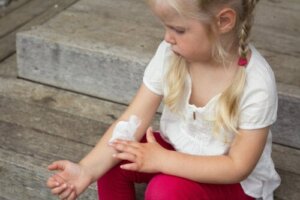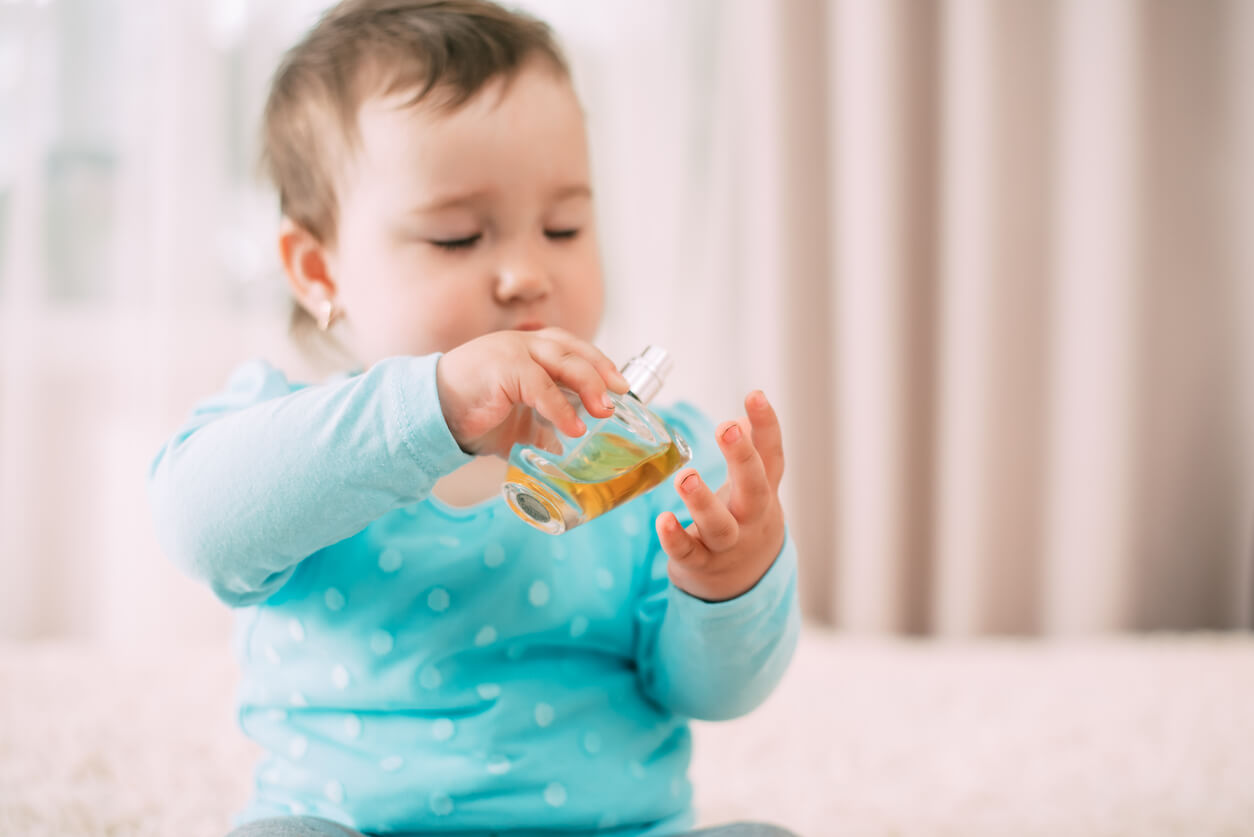10 Tips to Control Infantile Dermatitis


Written and verified by the dermatologist Maria del Carmen Hernandez
There are many tips to follow in order to control or avoid infantile dermatitis. It’s important to take into account that children’s skin isn’t yet fully developed, so it requires more precise care. In this article, we’ll provide you with 10 interesting tips.
Dermatitis is characterized by inflammation, scaling, and itching of the skin surface. It not only causes physical distress, but also discomfort and trouble sleeping at night.
Take note of these tips for managing infantile dermatitis
The best practices for a skin care regimen for infantile dermatitis are simple and precise. In fact, they should include daily bathing with a gentle cleanser, subsequent application of moisturizer, and, when needed, sunscreen. The main objective will be to restore or maintain the competent and functional protective skin barrier.
1. Moisturize the skin constantly
In addition to using cleansers during bathing, the use of emollients after bathing can also have great benefits. Moisturizing lotions decrease water loss through the skin and improve the skin’s condition. In addition, they supply lipids (ceramide, cholesterol, palmitate, and linoleate) and water.
2. Use mild hypoallergenic products
The skin of little ones is more prone to dryness and more fragile, so it’s best to use mild hypoallergenic products specifically formulated for their delicate needs. Therefore, cosmetics that don’t contain alcohol, colorants, synthetic fragrances, or parabens are ideal.

3. Bathing with lukewarm water
The correct temperature of the water to use is neither too hot nor too cold. Consequently, it should always be lukewarm water, and they shouldn’t spend more than 15 minutes in the shower or bath.
Then, to dry themselves, generating friction with the towel is contraindicated. Rather, it should be done with simple taps and, in the following minutes, put lotion or moisturizing oil on the skin.
4. Use unscented oils and soaps
Water’s insufficient to remove all oil-soluble impurities from the surface of the skin and has a poor pH buffering action. Because of this, a mild, unscented soap is best. In addition, it’s important that it doesn’t alter the surface pH or skin lipids and doesn’t cause irritation or dryness.
Oils are often used as emollients during the bathing process to remove impurities from the skin’s surface. In addition, according to studies conducted by the medical journal Current Medical Research and Opinion, they have the ability to reduce xerosis or leave a film on the surface of the skin.
You may be interested in: 10 Types of Dermatitis in Children
5. Use cotton garments
Those skins with susceptibility to irritations or dermatitis are sensitive to synthetic fabrics with anilines in their manufacturing process. Therefore, cotton garments or soft fabrics and natural fibers are the most suitable. It’s even better not to dress too warmly so as not to perspire excessively and, consequently, increase itching and infantile dermatitis.
6. Apply sun protection
The skin is the largest organ of the human body and the most exposed to aggressive external factors. Therefore, it must be cared for from the moment of birth. The use of sunscreen with a filter greater than 30 is one of the main indications to control or prevent infantile dermatitis.
In case of staying in open environments with recurrent sun exposure, the application of sunscreen should be renewed every two hours. There are even different presentations such as ointments, creams, gels, and sprays.
7. Use humidifiers
Although there are many factors that contribute to the hydration of the skin surface, the environment (wind, cold, or dry weather) can accelerate the loss of moisture in it. In this regard, humidifiers help to manage the environment, which is one of the best ways to control the skin.
In fact, maintaining the hydration levels of the air helps to keep the skin from drying out, as low humidity values alter the skin’s natural barrier, which can lead to itching, flaking, and cracking.

8. Limit the use of colognes and perfumes
Although it’s pleasant to smell a pleasant fragrance on the surface of the skin, it’s advisable not to abuse this type of cosmetic product. If you choose one of them, it’s important that it’s free of alcohol or substances that may cause allergic reactions.
Read also: Is Atopic Dermatitis Transmitted from Parents to Children?
9. Use therapeutic ointments
When the skin’s irritated, with scaling and noticeable evidence of infantile dermatitis, the first therapeutic option is ointments or creams with corticosteroids. These help to reduce inflammation and soothe the intense itching that leads to continuous scratching and secondary scaling lesions.
10. Hygiene as a premise
Cleansing and the use of emollients are two basic and simple strategies that can help to preserve healthy skin and control infantile dermatitis. Keeping the skin surface free of irritants and aggressors is ideal. However, excessive and abrasive hygiene with sponges isn’t beneficial either.
Infantile dermatitis and medical consultation
Although there are hygienic and care measures to control infantile dermatitis, you should never fail to resort to a specialist doctor and follow their indications. What’s more, you shouldn’t use home remedies for this type of dermatological disease.
There are many tips to follow in order to control or avoid infantile dermatitis. It’s important to take into account that children’s skin isn’t yet fully developed, so it requires more precise care. In this article, we’ll provide you with 10 interesting tips.
Dermatitis is characterized by inflammation, scaling, and itching of the skin surface. It not only causes physical distress, but also discomfort and trouble sleeping at night.
Take note of these tips for managing infantile dermatitis
The best practices for a skin care regimen for infantile dermatitis are simple and precise. In fact, they should include daily bathing with a gentle cleanser, subsequent application of moisturizer, and, when needed, sunscreen. The main objective will be to restore or maintain the competent and functional protective skin barrier.
1. Moisturize the skin constantly
In addition to using cleansers during bathing, the use of emollients after bathing can also have great benefits. Moisturizing lotions decrease water loss through the skin and improve the skin’s condition. In addition, they supply lipids (ceramide, cholesterol, palmitate, and linoleate) and water.
2. Use mild hypoallergenic products
The skin of little ones is more prone to dryness and more fragile, so it’s best to use mild hypoallergenic products specifically formulated for their delicate needs. Therefore, cosmetics that don’t contain alcohol, colorants, synthetic fragrances, or parabens are ideal.

3. Bathing with lukewarm water
The correct temperature of the water to use is neither too hot nor too cold. Consequently, it should always be lukewarm water, and they shouldn’t spend more than 15 minutes in the shower or bath.
Then, to dry themselves, generating friction with the towel is contraindicated. Rather, it should be done with simple taps and, in the following minutes, put lotion or moisturizing oil on the skin.
4. Use unscented oils and soaps
Water’s insufficient to remove all oil-soluble impurities from the surface of the skin and has a poor pH buffering action. Because of this, a mild, unscented soap is best. In addition, it’s important that it doesn’t alter the surface pH or skin lipids and doesn’t cause irritation or dryness.
Oils are often used as emollients during the bathing process to remove impurities from the skin’s surface. In addition, according to studies conducted by the medical journal Current Medical Research and Opinion, they have the ability to reduce xerosis or leave a film on the surface of the skin.
You may be interested in: 10 Types of Dermatitis in Children
5. Use cotton garments
Those skins with susceptibility to irritations or dermatitis are sensitive to synthetic fabrics with anilines in their manufacturing process. Therefore, cotton garments or soft fabrics and natural fibers are the most suitable. It’s even better not to dress too warmly so as not to perspire excessively and, consequently, increase itching and infantile dermatitis.
6. Apply sun protection
The skin is the largest organ of the human body and the most exposed to aggressive external factors. Therefore, it must be cared for from the moment of birth. The use of sunscreen with a filter greater than 30 is one of the main indications to control or prevent infantile dermatitis.
In case of staying in open environments with recurrent sun exposure, the application of sunscreen should be renewed every two hours. There are even different presentations such as ointments, creams, gels, and sprays.
7. Use humidifiers
Although there are many factors that contribute to the hydration of the skin surface, the environment (wind, cold, or dry weather) can accelerate the loss of moisture in it. In this regard, humidifiers help to manage the environment, which is one of the best ways to control the skin.
In fact, maintaining the hydration levels of the air helps to keep the skin from drying out, as low humidity values alter the skin’s natural barrier, which can lead to itching, flaking, and cracking.

8. Limit the use of colognes and perfumes
Although it’s pleasant to smell a pleasant fragrance on the surface of the skin, it’s advisable not to abuse this type of cosmetic product. If you choose one of them, it’s important that it’s free of alcohol or substances that may cause allergic reactions.
Read also: Is Atopic Dermatitis Transmitted from Parents to Children?
9. Use therapeutic ointments
When the skin’s irritated, with scaling and noticeable evidence of infantile dermatitis, the first therapeutic option is ointments or creams with corticosteroids. These help to reduce inflammation and soothe the intense itching that leads to continuous scratching and secondary scaling lesions.
10. Hygiene as a premise
Cleansing and the use of emollients are two basic and simple strategies that can help to preserve healthy skin and control infantile dermatitis. Keeping the skin surface free of irritants and aggressors is ideal. However, excessive and abrasive hygiene with sponges isn’t beneficial either.
Infantile dermatitis and medical consultation
Although there are hygienic and care measures to control infantile dermatitis, you should never fail to resort to a specialist doctor and follow their indications. What’s more, you shouldn’t use home remedies for this type of dermatological disease.
All cited sources were thoroughly reviewed by our team to ensure their quality, reliability, currency, and validity. The bibliography of this article was considered reliable and of academic or scientific accuracy.
- Simpson EL, Berry TM, Brown PA, Hanifin JM. A pilot study of emollient therapy for the primary prevention of atopic dermatitis. J Am Acad Dermatol. 2010 Oct;63(4):587-93. doi: 10.1016/j.jaad.2009.11.011. Epub 2010 Aug 7. PMID: 20692725; PMCID: PMC3156679.
- Bettzuege-Pfaff BI, Melzer A. Treating dry skin and pruritus with a bath oil containing soya oil and lauromacrogols. Curr Med Res Opin. 2005 Nov;21(11):1735-9. doi: 10.1185/030079905X62963. PMID: 16307693.
- Agache P, Makki S, Blanc D, Constans S, Michalet D. Skin care in childhood. Curr Med Res Opin. 1982;7(Suppl 2):15-22. PMID: 7105804.
- Fernandes JD, Machado MC, Oliveira ZN. Children and newborn skin care and prevention. An Bras Dermatol. 2011 Jan-Feb;86(1):102-10. English, Portuguese. doi: 10.1590/s0365-05962011000100014. PMID: 21437530.
This text is provided for informational purposes only and does not replace consultation with a professional. If in doubt, consult your specialist.








